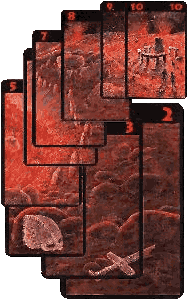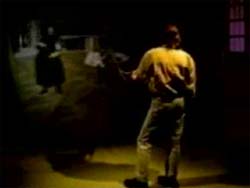Good Puzzle Game
Another game:
http://www.gamesgnome.com/dynamicpuzzles/bridges/
Looks easy but can be frustratingly difficult.
Have fun!
Fueled by New Mexico State University's Learning Games Initiative and Learning Games Lab, this blog will chronicle issues we deal with in creating educational games. We'll be posting responses to research we've done or read, musing on challenges we've faced in creating games, and pondering activities to help new game developers learn. The Learning Games Initiative and Lab is run by Barbara Chamberlin, Ph.D. and administered by Agricultural Communications.
Another game:
After hearing that Leapster used a Flash-based engine and thinking we might be able to deliver content for it, I did a little poking around to see if there were any developer programs. It then seemed like LeapFrog had a very closed developer program - in fact, only LeapFrog could develop for it. However, this comment over at watercoolergames points to a statement from LeapFrog that they plan to "expand its network of third-party publishers," presumably for the upcoming FLY pentop computer this Fall. Of course, who knows if the FLY will be Flash based, so maybe this is just a dead end for our particular products.
As we continue development on our Pirate science web-based games, we continue to challenge ourselves in creating engaging gameplay with accurate content. Why is it so hard to create games that are fun and educational? Here are my thoughts:
The BBC is running a Kid's Game Design Competition for 13-19 year olds. The kids submit game designs based on art, film, music, writing, or dance, and the game design guru Peter Molyneux will judge the entries. The winner will have his or her game idea translated into an online game, and the runner-ups will have their ideas showcased with expert feedback.
Since we're working on a pirate-themed educational game currently, I thought it would be good to point out the competition. Apparently, Disney is working on a MMO Pirates of the Carribbean game.
It is hard to create learning games that have engaging game play. Gosh... it's hard enough just creating games with engaging game play... to add meaningful content makes it even harder.
Here is an interesting game mechanic for experimenting. You have to try out different combinations that will allow you to get through the puzzle.
First Post. Woohoo! I know most of you are already familiar with Orsinal but I thought I would refresh your memories. This guy's games are beautiful and fun. Not a great deal of educational value but they are generally easy on game mechanics and easy on the eye to boot.
 The United Nations World Food Programme has released Food Force, a 3D educational game to teach 8-13 year old children about world hunger.
The United Nations World Food Programme has released Food Force, a 3D educational game to teach 8-13 year old children about world hunger.The game itself consists of six missions. Each mission begins with a briefing by one of the Food Force characters, who explains the challenge ahead. The player then has to complete the task - in which points are awarded for fast and accurate play and good decision making. Each mission uses a different style of gameplay to appeal to children of all abilities. Each mission represents a key step of the food delivery process - from emergency response through to building long-term food security for a community. Following each mission a Food Force character returns to present an educational video showing the reality of WFP’s work in the field. This allows children to learn and understand how WFP responds to actual food emergencies: Where food originates, the nutritional importance of meals, how food is delivered and how food is used to encourage development.Players can even compete for high scores online.
 Found an interesting press release from back in 2003 by Macromedia. Apparently, the Leapster handheld console, aimed at the education market, has an embedded Flash player. It's not clear from the press release whether you could use Flash as the development platform or not, but perhaps our Flash-based games could find a home on the Leapster handheld.
Found an interesting press release from back in 2003 by Macromedia. Apparently, the Leapster handheld console, aimed at the education market, has an embedded Flash player. It's not clear from the press release whether you could use Flash as the development platform or not, but perhaps our Flash-based games could find a home on the Leapster handheld.
Here's a link to the Entertainment Software Association. They do some interesting studies on who plays video games, what they play, what age/ gender they are, etc.
Back in 1982, Chris Crawford (Atari alum, author of Balance of Power and founder of the CGDC) wrote a book called The Art of Computer Game Design. Now, the full text is available online. Here's a sample of some of the chapter titles:
The games industry is like a big building with one entrance and a lot of exits. There are thousands of eager young kids crowded at the front entrance, pushing and shoving to get inside; only a few make it in. But for every person who gets in, another person leaves -- that's what keeps the industry in balance. And the fact that so many of the people in the business are so young demonstrates who quickly people bail out of the industry. Not many survive until their thirties.This sort of thing might be the salvation of a game development program that doesn't try to drop people directly into the big game development houses. We can perhaps offer an alternative to the millstone.
More info on the Adobe / Macromedia merger. According to this article on InternetNews:
Purchasing Macromedia would help Adobe stake new ground for selling graphics software to mobile and enterprise segments, which Adobe CEO Bruce Chizen said on a conference call would help Adobe customers cope better with the explosion in digital information.Sounds like the impetus for the acquisition is to acquire Flash-on-device tech which is starting to make inroads on palmtops and mobile phones. Not surprisingly, then, there's no mention of Director in the article.
"Together, we will be able to offer customers full, integrated solutions for next-generation communication and interaction, especially on non-PC devices," Chizen said, noting that the high-tech sector is seeing evolving methods of accessing that information, including documents, images, Internet, television and new wireless and non-PC devices.
The Games Journal is a monthly online newsletter about game design, development, and culture. The articles are short, and it's mostly about board game design, but there are some interesting tidbits to be found throughout the issues.
 With upwards of 16700 games in its database, BoardGameGeek is quite a reference for people looking to troll for game design ideas. The game database is searchable, and also browseable by name, by player rating, and by category (including "Educational"). But the really interesting part for game designers is that it is browseable by game mechanic, so you could quickly browse through some games with, say, modular board systems.
With upwards of 16700 games in its database, BoardGameGeek is quite a reference for people looking to troll for game design ideas. The game database is searchable, and also browseable by name, by player rating, and by category (including "Educational"). But the really interesting part for game designers is that it is browseable by game mechanic, so you could quickly browse through some games with, say, modular board systems.CNN profiles Tim Ryland's efforts in using Myst as a prompt for creative writing in his English classes. I love hearing about alternative uses of games... though it doesn't sound as though Mr. Ryland is using the game aspect of Myst as much as the immersive environment created for the game. It speaks to the power of the gaming environment in educational uses. I suspect being heralded in CNN is enough of a kudo for Mr. Ryland that my own "thumbs up" is meaningless... none-the-less... "Thumbs Up Mr. Ryland!"
 Back in 1998, when CAVE technology was still young, a CAVE program called Las Maninas was created. It was an immersive learning environment designed to allow the viewer to explore the world of the famous Spanish painter Diego Velásquez from within his paintings and through the eyes of those who were influenced by his work, like Picasso and Medvedev.
Back in 1998, when CAVE technology was still young, a CAVE program called Las Maninas was created. It was an immersive learning environment designed to allow the viewer to explore the world of the famous Spanish painter Diego Velásquez from within his paintings and through the eyes of those who were influenced by his work, like Picasso and Medvedev.MSNBC has posted an article discussing MySecureCyberspace, a game using popular cartoons to help kids recognize spam and unsavory characters in chat rooms. No link is given to the game itself, which will be distributed later in the summer. The product is out of Carnegie Mellon.
Adobe has just put up a press release indicating that Adobe is going to acquire Macromedia. This, of course, fills me with dread that the bean-counters at Adobe might kill Director. But if they've got vision over there, they could see the huge opportunity that Shockwave3D offers them to dominate web 3D. We'll see what they do.
 Game Gardens is "a place to play online multiplayer games and a place for game developers to create their own multiplayer games and host them for others to come and play." While you can just go there to play the games, the real focus appears to be encouraging hobbyist game development, specifically with regard to experimentation in multiplayer gaming experiences. As such, you will find the downloadable source code to several games, and an online forum supporting the development of games.
Game Gardens is "a place to play online multiplayer games and a place for game developers to create their own multiplayer games and host them for others to come and play." While you can just go there to play the games, the real focus appears to be encouraging hobbyist game development, specifically with regard to experimentation in multiplayer gaming experiences. As such, you will find the downloadable source code to several games, and an online forum supporting the development of games.
Roger Giner-Sorolla, a Psychology professor at NYU, wrote an article called Crimes Against Mimesis a while back about game design for Interactive Fiction (IF). Although the content is largely aimed at the Zork-like text adventure games, there are points inside that apply to the wider realm of the Adventure genre (into which many modern educational games fall). Mainly, it deals with the relationship between the game designer's intent and the game player's experience, and where breakdowns occur between them.
As we discuss the possiblity of a game development major at New Mexico State University (our Creative Media degree includes film making and animation... I'm hoping game development will be included in the next phase), I feel strongly that we should not aim to prepare graduates to work at one of the major game development studios. Rather, I'd like our university to emphasize small-group development and preparation of that work force.
 Apple has posted a survey of recent edutainment titles that covers quite a few games. This goes hand in hand with their Getting Started with Kids and Learning Games pages which has a more exhaustive list of edutainment titles (at least, the ones which are available for Mac).
Apple has posted a survey of recent edutainment titles that covers quite a few games. This goes hand in hand with their Getting Started with Kids and Learning Games pages which has a more exhaustive list of edutainment titles (at least, the ones which are available for Mac).
Today, we took another step towards our Learning Games Lab -- decoration. We need to decide what colors to paint the walls, how to arrange furniture, and what kind of furniture to buy. The university's interior decorator reminded us that kids get melancholy from dark colors... it got me thinking... what kind of mood do we want our game lab to evoke?
In thinking about our game lab, it might be of interest to read some of James Paul Gee’s work.

The creator of the classic hit "SimCity," Will Wright, said that SimCity wasn't a game, but a toy, pointing out that it was merely a simulation with no overt goals impressed against the player. Indeed, the enjoyment of the game comes from setting and pursuing goals for yourself while playing the game, such as "How big a city can I make?" or "How small a city can I make with the biggest population?" or "How miserable can I make life for my
For anyone who doubts that even the most rudimentary of educational games can have a profound impact on someone, be sure to check out Oregon Trail Online, which is a fan game recalling the oddly entertaining 1988 educational game "Oregon Trail." The game only incorporates the one violent part of the game (namely, blasting the hapless wildlife) and some small related parts (trading animal carcasses for more supplies, namely, more bullets to blast hapless wildlife with), but obviously, the game stayed with the authors for the intervening 17 years. It's just too bad they didn't try to recreate the best part.
I imagine several 'models' exist of the process of game design... certainly several exist in instructional design. However, I prefer to think of the process as a dynamic one... changing with each design team. While I'm not naive enough to believe that the process we use on our current game design will be the same one we use next time -- at least I'm hoping it won't be -- reflection will help me remember when inspiration struck, and which part of the processes bear repeating.
Here is a link to an game that came out of a constructivist learning (not teaching) setting in a kinder classroom. If you're familiar with the "centers" approach in the classroom - you'll recognize that this is a piece of that approach and one of four modules for self directed knowledge making when it comes to shapes.
Gamasutra Industry News is reporting that West Virginia is dropping $60K to put about 100 Dance Dance Revolution video game consoles in public schools and kids' homes. The catch? The kids are required to play, and must wear a pedometer. The idea is to study whether kinetic games like DDR can help prevent obesity if they are introduced at an early age.
Quite a while ago, Greg Costikyan pointed out the need for a taxonomy and rigorous language to define and explore games and game development. His article, I Have No Words & I Must Design, is a great discussion of some of the topics and considerations that game designers need to come to grips with if they wish to further their art.
Our Learning Games Initiative at New Mexico State University has begun. While we've been involved in interactive game development for some time, this is my attempt to bring people from other academic fields into that process. My goals for the initiative are simple: enable discussion, practice, development and research on learning through game play. I'm thrilled that we have interest in the initiative from several disciplines.